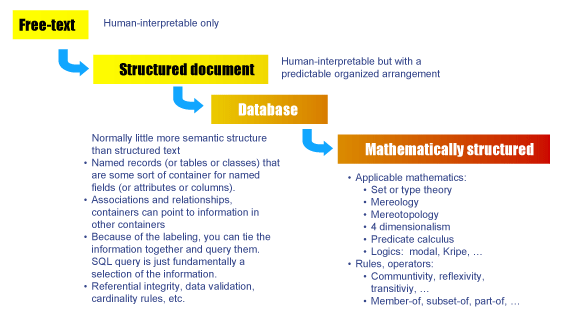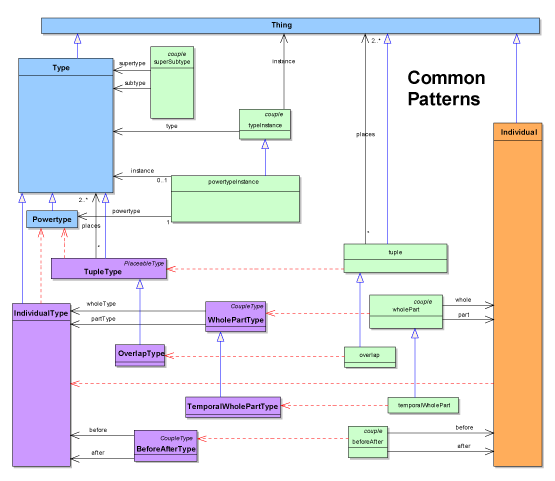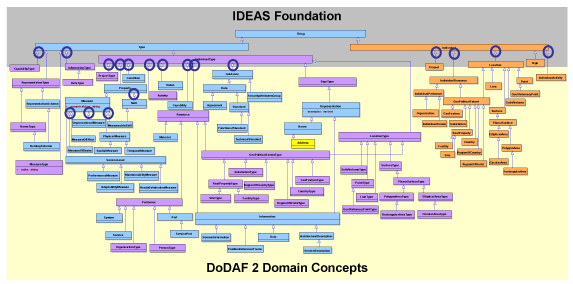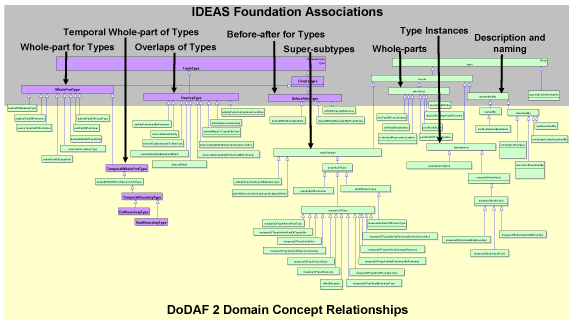DM2
DoDAF Formal Ontology
The DM2 is founded upon the International Defence Enterprise Architecture Specification (IDEAS) (http://www.ideasgroup.org or http://en.wikipedia.org/wiki/IDEAS_Group) a formal ontology foundation developed by the defense departments and ministries of the United States, United Kingdom, Canada, Australia, and Sweden in coordination the North Atlantic Treaty Organization (NATO). All DoDAF concepts and concept relationships inherit several rigorously defined mathematical properties from the IDEAS Foundation. A view of the upper levels of the IDEAS Foundation is shown in the figure below.
IDEAS Foundation Top-Level
The IDEAS Foundation is higher-order. It is extensional (see Extension [metaphysics]), using physical existence as its criterion for identity. In practical terms, this means the ontology is well suited to managing change-over time and identifying elements with a degree of precision that is not possible using names alone. The methodology for defining the ontology is very precise about criteria for identity by grounding reasoning about whether two things are the same using something that can be accurately identified. So, comparing two individuals, if they occupy precisely the same space at the same time, they are the same. Clearly this only works for individuals, but the principle can be used to compare types too. For two types to be the same, they must have the same members. If those members are individuals, their physical extents can be compared. If the members are types, then the analysis continues until individuals are reached, then they can be compared. The advantage of this methodology is that names are separated from things and so there is no possibility of confusion about what is being discussed. It is also four dimensionalist so that temporal parts (or states) can be represented, along with before-after behaviors. A partial bibliography of research and reference material used in deriving the IDEAS Foundation is included in the appendix to this document.
None of these foundation properties are unusual; they are all used in reasoning everyday. The basic concepts are:
- Three basic types of Things:
- Individuals are Things that exist in 3D space and time, i.e., have 4D spatial-temporal extent.
- Types, sets or collections of things. Two important Types are distinguished – ones whose members are Individuals and those whose members are other than Individuals. This is an important distinction between naïve set theory and type theory.
- Tuples, ordered relations between things, e.g., ordered pairs in 2D analytic geometry, rows in relational database tables, and subject-verb-object triples in Resource Description Framework.
- Basic relationships:
- Set theoretic:
- Super-subtype; e.g., a type of system or service, capability, materiel, organization, or condition.
- Type-instance, similar to “element of” in set theory
- Mereologic:
- Whole-part; e.g., components of a service or system, parts of the data, materiel parts, subdivisions of an activity, and elements of a measure.
- Temporal whole-part; e.g., the states or phases of a performer, the increments of a capability or projects, the sequence of a process (activity).
- 4D Topologic:
Items of note:
-
Types include sets of Tuples and sets of sets.
-
Tuples can have other Tuples in their tuple places.
-
The participants in a super-subtype relationship can be from the same class, e.g., the supertype can be an instance of Measure Type as well as the subtype. This allows for representation of as much of a super-subtype taxonomy as is needed.
- Power Type members are generated from some Type by taking all the possible subsets of the members of the Type.
- For example, take the Individual Type AIRCRAFT, whose members include all the aircraft of the world.
- Some of these subsets are not used by anyone, e.g., the full set, the null set, or just some random subset. However, the second one, which might be name F-15 Type, is quite useful. The last example is not useful to most unless you are interested in the first (assuming the subscript 1 means first) of any particular aircraft type, e.g., if you were doing a study of first-off-the-line aircraft production lessons-learned. This is the usefulness of Power Types and why they are employed in DM2: they allow for multiple categorization schemes, according to someone else’s use, yet traceability back to the common elements so that the relationships between multiple categorization schemes can be understood. This was a DM2 requirement – multiple categorization schemes or taxonomies – because across a large enterprise it is not possible to employ a single categorization scheme; rather schemes vary depending on function. For example, a weaponeer’s classifies ordnance is naturally different from a logistician’s, the former concerned with delivery means, lethality, etc. and the latter with weight, size, and other transportation issues.
- Note also that a powerset can then be taken of the powerset. This allows for build up of what is often called a taxonomic hierarchy. These are quite useful in enterprise Architectural Descriptions.
The DM2 utilizes the formal ontology of IDEAS because it provides:
- Mathematical rigor needed for precision Architectural Descriptions that can be analyzed and used in detailed processes such as Systems Engineering and Operations Planning.
- type (~set) theory
- 4D mereotopology
- Deals with issues of states, powertypes, measures, space -- what is truly knowable vs. what is assumed
- Separates signs and representations from referents
- DM2 domain concepts are extensions to the formal foundation
- Rigorously worked-out common patterns are reused: Super-subtype, whole-part, temporal whole-part, type-instance, before-after, overlap
- Saved a lot of repetitive work – “ontologic free lunch”
- Model compactness through inheritance of superclass properties and common patterns.
- Economizes implementations
- Higher quality and consistency throughout due reuse of the rigorously worked-out common patterns
- Improved interoperation with Unified Profile for DoDAF and MODAF (UPDM)-SysML tools which are following IDEAS concepts.
- Improved opportunities for Coalition and NATO data exchange since MODAF is following IDEAS and NAF is interested in following IDEAS.
- Agreed-upon analysis principles that provide a principled basis for issue analysis
- Better ability to integrate and analyze EA data for EA purposes.
The advantage over free-text, structured documents, and databases in using this type of mathematically structured information is somewhat explained by the figure below that shows a spectrum of information structuring.

A Spectrum of Information Structuring
This shows that databases are really just storage and retrieval with connections only for exactly matching pieces of information (e.g., "keys" or exactly matching strings). The nature and purposes of EA require more than just storage, retrieval, and exchange, e.g., integration, analysis, and assessment across datasets. Founding DM2 on IDEAS provides the ontologic foundation supports entailment and other sorts of mathematical understanding of the data with membership (~ set theory) and 4D mereotopology (parts and boundaries). Some of these structures are so fundamental in human reasoning that it's hard to see that computers don't have it at all. But they are needed if we want to use them for something more than just storage and retrieval. They have to be encoded it into them with formal methods.
Common Patterns
The re-use patterns useful to Architectural Descriptions are shown in the figure below.

DM2 Common Patterns
The IDEAS foundation concepts, common to all data groups are shown in the table below. It is important to remember that even though these are not repeated in the descriptions of the data groups, they are nevertheless present in the model and apply to the data group concepts according to the Doman Class Hierarchy shown in the figures below.
IDEAS Foundation Concepts Applicable to all DoDAF Data Groups
|
IDEAS Concept
|
Definition
|
|
Classes
|
|
DescriptionScheme
|
A RepresentationScheme and DescriptionType whose members are intentionally descriptions
|
|
IndividualPerformer
|
A specific thing that can perform an action
|
|
Information
|
Information is the state of a something of interest that is materialized -- in any medium or form -- and communicated or received.
|
|
InformationType
|
Category or type of information
|
|
Location
|
A point or extent in space that may be referred to physically or logically.
|
|
LocationType
|
The powertype of Location
|
|
Measure
|
The magnitude of some attribute of an individual.
|
|
MeasureType
|
A category of Measures
|
|
Performer
|
Any entity - human, automated, or any aggregation of human and/or automated - that performs an activity and provides a capability.
|
|
Representation
|
A SignType where all the individual Signs are intended to signify the same Thing.
|
|
RepresentationScheme
|
A RepresentationType that is a collection of Representations that are intended to be the preferred Representations in certain contexts.
|
|
Resource
|
Data, Information, Performers, Materiel, or Personnel Types that are produced or consumed.
|
|
Rule
|
A principle or condition that governs behavior; a prescribed guide for conduct or action
|
|
ServiceLevel
|
A measurement of the performance of a system or service.
|
|
Thing
|
The union of Individual, Type, and tuple.
|
|
Associations
|
|
BeforeAfter
|
A couple that represents that the temporal extent end time for the individual in place 1 is less than temporal extent start time for the individual in place 2.
|
|
BeforeAfterType
|
An association between two Individual Types signifying that the temporal end of all the Individuals of one Individual Type is before the temporal start of all the Individuals of the other Individual Type.
|
|
describedBy
|
A tuple that asserts that Information describes a Thing.
|
|
descriptionSchemeInstance
|
A representationSchemeInstance that asserts a Description is a member of a DescriptionScheme.
|
|
endBoundary
|
A temporal whole part couple that relates the temporal boundary to the whole.
|
|
EndBoundaryType
|
A temporal whole part couple that relates the temporal boundary to the whole taken over a Type.
|
|
measureOfIndividualEndBoundary
|
endBoundary is a member of Measure
|
|
measureOfIndividualStartBoundary
|
startBoundary is a member of Measure
|
|
measureOfTypeEndBoundaryType
|
endBoundaryType is a member of Measure
|
|
measureOfTypeStartBoundaryType
|
startBoundaryType is a member of Measure
|
|
namedBy
|
A couple that asserts that a Name describes a Thing.
|
|
namingSchemeInstance
|
A representationSchemeInstance that asserts a Name is a member of a NamingScheme.
|
|
overlap
|
A couple of wholePart couples where the part in each couple is the same.
|
|
OverlapType
|
An overlap in which the places are taken by Types only.
|
|
representationSchemeInstance
|
A typeInstance that asserts a Representation is a member of a RepresentationScheme.
|
|
representedBy
|
A couple that asserts that a Representation represents a Thing.
|
|
startBoundary
|
The beginning of a temporalBoundary.
|
|
StartBoundaryType
|
The beginning of a temporalBoundaryType.
|
|
superSubType
|
An association in which one Type (the subtype) is a subset of the other Type (supertype).
|
|
temporalBoundary
|
The start and end times for the spatio-temporal extent of an Individual
|
|
TemporalBoundaryType
|
The start and end times for the Individual members of a Type.
|
|
temporalWholePart
|
A wholePart that asserts the spatial extent of the (whole) individual is co-extensive with the spatial extent of the (part) individual for a particular period of time.
|
|
TemporalWholePartType
|
A couple between two Individual Types where for each member of the whole set, there is a corresponding member of the part set for which a wholePart relationship exists, and conversely
|
|
typeInstance
|
A Thing can be an instance of a Type - i.e. set membership. Note that IDEAS is a higher-order model, hence Types may be instances of Types.
|
|
wholePart
|
A couple that asserts one (part) Individual is part of another (whole) Individual.
|
|
WholePartType
|
A coupleType that asserts one Type (the part) has members that have a whole-part relation with a member of the other Type (whole).
|

DM2 Domain Concepts are Subtypes (Extensions) of IDEAS Foundation Concepts

DM2 Associations are Subtyped to IDEAS Mathematical Associations
IDEAS Foundation Mathematics
When creating or analyzing DM2 data, the following mathematical properties should be followed. (Note, this material is incomplete and will be provided in later versions of either DM2 or IDEAS documentation. Additional sources for ontologic mathematics include: 1) National Center for Ontologic Research (NCOR), http://ontology.buffalo.edu/smith/; 2) Direct Model-Theoretic Semantics for OWL 2, http://www.w3.org/TR/2009/REC-owl2-direct-semantics-20091027/)
Type Theory Math
Mereotopologic Math
IDEAS Foundation Partial Bibliography
- Berger, Peter L, and Thomas Luckmann; The Social Construction of Reality; Doubleday & Company, Garden City, New York; 1966.
- Casati, Roberto, and Achille C Varzi; Holes and other Superficialities; The MIT Press, Cambridge, Massachusetts; 1995.
- Casati, Roberto, and Achille C Varzi; Parts and Places: The Structure of Spatial Representation; The MIT Press, Cambridge, Massachusetts; 1999.
- Clark, Bowman L; “Individuals and Points”; Notre Dame Journal of Formal Logic, Vol. 26; 1985.
- Coquand, Thierry; “Type Theory”; Stanford Encyclopedia of Philosophy; 2006.
- Davenport, Thomas H, and Laurence Prusak; Working Knowlege: How Organizations Manage What They Know; Harvard Business School Press, Boston, Massachusetts; 1998.
- Gilbert, Margaret; On Social Facts; Princeton University Press, Princeton, New Jersey; 1992.
- Grenon, Pierre, and Barry Smith; “The Cornucopia of Formal-Ontological Relations”; Dialectica. Vol. 58; 2004
- Grenon, Pierre, and Barry Smith; “Snap and Span: Toward Dynamic Spatial Ontology”; Spatial Cognition and Computation; Lawrence Erlbaum Assosiates, Inc, Leipzig, Germany.
- Hacking, Ian; Historical Ontology; Harvard University Press, Cambridge, Massachusetts; 2002.
- Hawley, Katherine; How Things Persist; Oxford University Press, Oxford; 2001
- Janssen, Terry, et al; A Multi- INT Sematic Reasoning Framework for Intelligence Analysis Support
- Kay, Paul; “Taxonomy and Semantic Contrast”; Language; Vols. 47, number4; University of California, Berkeley, CA, 1971.
- Kempson, Ruth M; Semantic Theory; Cambridge University Press, Cambridge; 1977.
- Levinson, Stephen C; Pragmatics; Cambridge University Press, Cambridge; 1984.
- Lyons, John; Language, Meaning, & Context; Fontana Paperbacks, Great Britain; 1981.
- Nerlich, Graham; The Shape of Space; Second ed; Cambridge University Press,New York, NY; 1994.
- Partee, Barbara H, Alice Ter Meulen, and Robert E Wall; Mathematical Methods in Linguistics, Vol. 30; Kluwer Academic Publishers, Dordrecht; 1990.
- Partridge, Chris; Business Objects: Re-Engineering for Re-Use; The Boro Centre; 2005.
- Potter, Michael; Set Theory and its Philosophy; Oxford University Press, Oxford; 2004.
- Pulman, S G; Word Meaning and Belief; Ed. James R Hurford and John A Hawkins; Croom Helm Linguistics Series; Billing & Sons Limited, Great Britain; 1983.
- Rea, M. C., “Four Dimensionalism” in The Oxford Handbook for Metaphysics. Oxford Univ. Press
- Sider, Theodore; Four Dimensionalism: An Ontology of Persistence and Time; Oxford University Press, Oxford; 2001.
- Simons, Peter; Parts: A Study in Ontology; Oxford University Press, Oxford; 1987.
- Smith, Barry; “Against Fantology”; Experience and Analysis; By M E Reicher and J C Marek; 2005.
- Smith, Barry; “The Basic Tools of Formal Ontology”; Formal Ontology in Information Systems; IOS Press, Amsterdam; Frontiers in Artifitial Intellegence and Applications; 1998
- Smith, Barry; “Mereotopology: A Theory of Parts and Boundaries”; Data and Knowledge Engineering; Department of Philosophy, Buffalo, New York; 1996.
- Smith, Barry, and David M Mark; “Do Mountains Exist? Toward an Ontology of Landforms.” Enviorment & Planning B (Planning and Design); National Center for Geographic Information and Analysis, Buffalo, New York; 2009.
- Stein, Lynn Andrea; “Imagination and Situated Cognition”; Thinking about Android Epistemology; Ed. Kenneth M Ford, Clark Glymour, and Partick J Hayes; AAAI Press, Menlo Park; 2006. Sider, Theodore. “Four Dimensionalism”. Philosophical Review. pp. 197-231